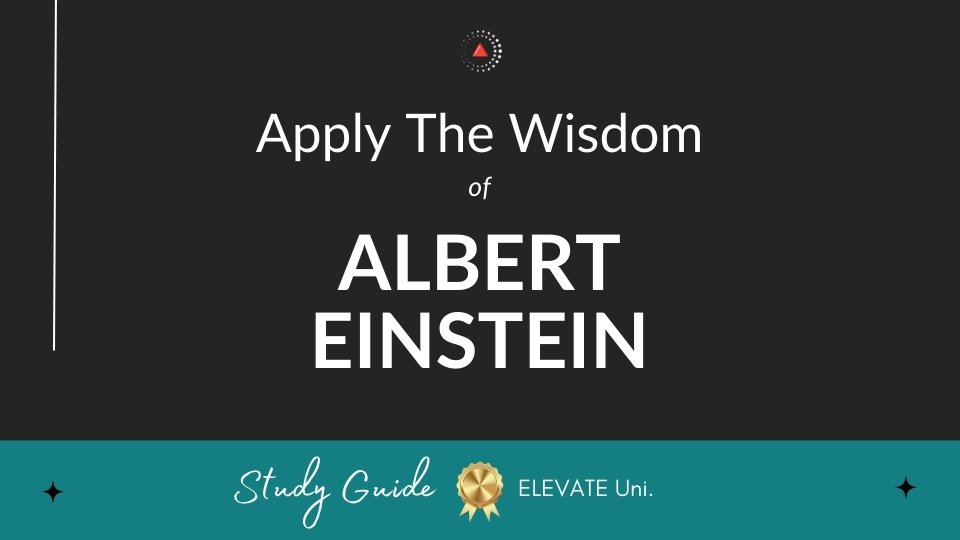We can’t solve problems by using the same kind of thinking we used when we created them.
What's the meaning of this quote?
Quote Meaning: This quote highlights the necessity of approaching problems from a fresh perspective and embracing innovative thinking when seeking solutions. Our initial thought processes may have led to the creation of a problem or perpetuated an existing issue, and attempting to rectify the situation with the same mindset is likely to be fruitless. Instead, the quote suggests that we should examine our problems through a new lens, challenging our assumptions and exploring alternative viewpoints. This approach encourages critical thinking and fosters the generation of creative solutions, which can lead to more effective and lasting resolutions. Additionally, the quote serves as a reminder of the importance of adaptability and self-awareness, as recognizing the need for a shift in thinking is the first step towards making meaningful change.
Who said the quote?
The quote "We can't solve problems by using the same kind of thinking we used when we created them." was said by Albert Einstein (Bio / Quotes). Albert Einstein was a German physicist and Nobel Prize winner who is widely regarded as one of the most influential scientists in history.
Applying the quote to your life
Unlock Einstein's wisdom and apply it to your life by getting the in-depth Albert Einstein Workbook & Study Guide, complete with top quotes, insightful commentary, reflective questions, and practical uses for everyday life. 👇
To apply more wisdom, get the All-Access Pass, which includes hundreds of study guides from the world's top minds. These include deep insights from individuals such as Nelson Mandela, Steve Jobs, and Albert Einstein, as well as some of the top authors and personal development books.
What are Albert Einstein's Best Quotes?
Watch on Elevate's YouTube channel and be sure to subscribe for more wisdom and insights from the world's top minds.
Subscribe on YouTube to get the latest quote videos delivered straight to you:
Is there a historical example that illustrates the message of the quote?
A powerful historical example that illustrates the quote "We can't solve problems by using the same kind of thinking we used when we created them" is the approach taken by the United States during the Great Depression of the 1930s. The initial response to the economic crisis, triggered by the 1929 stock market crash, was largely based on the same economic principles that had contributed to the crisis—namely, a reliance on laissez-faire capitalism and minimal government intervention.
President Herbert Hoover's administration, which was in power at the onset of the Great Depression, adhered to the belief that the market would correct itself without much governmental interference. This approach was rooted in the same economic thinking that had allowed the boom-and-bust cycles of the 1920s to persist. However, as the economic situation worsened, it became clear that the existing strategies were insufficient.
In response to the deepening crisis, President Franklin D. Roosevelt's administration introduced the New Deal—a series of unprecedented economic and social reforms that marked a significant departure from previous policies. This new approach involved extensive government intervention, public works programs, and regulatory reforms designed to provide immediate relief, stimulate economic recovery, and prevent future depressions.
The shift in thinking from a hands-off approach to one of active government involvement was crucial in addressing the crisis. By rejecting the old methods and embracing new strategies, the New Deal successfully mitigated some of the worst effects of the Great Depression and laid the groundwork for future economic stability.
This historical example vividly demonstrates how clinging to outdated methods can exacerbate problems, and how innovative thinking can lead to more effective solutions.
How can the quote be applied in a real-life scenario?
The quote "We can't solve problems by using the same kind of thinking we used when we created them" is highly relevant in many real-life situations, especially when addressing complex or persistent challenges. Consider the scenario of a company facing declining employee morale and productivity. If the management team attempts to address these issues using the same strategies that may have contributed to the decline—such as rigid top-down decision-making or inadequate communication—there's a high likelihood that the problems will persist or even worsen.
To effectively tackle this issue, the company would need to shift its approach. For example, instead of maintaining a hierarchical structure with limited feedback channels, management could implement a more collaborative approach. This might involve creating open lines of communication, involving employees in decision-making processes, and fostering a more supportive work environment.
By adopting new methods and encouraging innovative thinking, the company can address the root causes of low morale and productivity. This might include offering professional development opportunities, recognizing and rewarding employee contributions, or improving work-life balance. Such changes are designed to create a more positive and productive workplace, in contrast to the old practices that may have contributed to the initial decline.
In this way, applying the quote in real life means recognizing when current methods are ineffective and being willing to embrace new ideas and strategies. It’s about understanding that solving problems often requires stepping outside of existing frameworks and considering alternative approaches. By doing so, individuals and organizations can achieve better outcomes and address challenges more effectively.
Chief Editor
 Tal Gur is an author, founder, and impact-driven entrepreneur at heart. After trading his daily grind for a life of his own daring design, he spent a decade pursuing 100 major life goals around the globe. His journey and most recent book, The Art of Fully Living, has led him to found Elevate Society.
Tal Gur is an author, founder, and impact-driven entrepreneur at heart. After trading his daily grind for a life of his own daring design, he spent a decade pursuing 100 major life goals around the globe. His journey and most recent book, The Art of Fully Living, has led him to found Elevate Society.






















